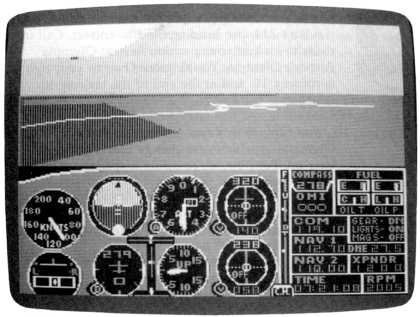40 More Great Flight Simulator Adventures
by Charles Gulick

Tradewinds
| North Position: 21219 | Rudder: 32767 |
| East Position: 6343 | Ailerons: 32767 |
| Altitude: 204 | Flaps: 0 |
| Pitch: 0 | Elevators: 32767 |
| Bank: 0 | Time: 7:00 |
| Heading: 214 | Season: 3-Summer |
| Airspeed: 0 | Wind: 0 Kts, 0 |
| Throttle: 0 | |
Important: Change Slew to 1 for this mode. |
|
  |
Check your heading when you exit
the editor, and if it isn't 214, use
heading Slew to correct. Call up radar to look at your position here at
Olympia Airport, Olympia, Washington. Over to your right is runway 17,
and at the end of the taxiway to your left is runway 26. You can use this spot as your tie-down at Olympia, in which case change Slew back to 0 later on. For now, we're off on a special adventure. |
 |
Slew up to an altitude of 5000
feet, then slew your heading to the right to 270 degrees. Now slew west, watching the East Position value at the top of your screen and establishing a rate of about one digit per second. Opposite slew will slow you down if you accidentally go too fast. Or you can simply freeze and restart to establish the desired rate. The Pacific Ocean will come into view. Use radar to take a view from the highest possible altitude. Keep that radar setting, but return to your out-the-windshield observation. One thing we'll find out this morning is how much Pacific Ocean there is in the simulation. Well, not a great deal. Everything's green again, including radar. But take my word for it, even though it's all green, it's still essentially ocean. Increase your westward slew until you achieve a rate where the hundreds are changing about every second. Closely watch the East Position value as it approaches 0. Now we're looking at minus values (32767 is the maximum value anywhere). Increase the westward slew to a rate where the thousands change every second or so, and watch for -32767 to go by. Sure enough. Well before you get to East 22000, slow down so you can freeze the slew at that parameter. If you should go a few digits past it, just slew east to get back. Now slew south at a brisk rate, but observe the North parameter carefully. Slow up soon enough to freeze on a parameter of North 18100. Check that your North and East parameters are 18100 and 22000 respectively, that your altitude is about 5000 feet, and that your heading is 270. Then enter the editor and do only the following: • Change slew to 0. • Change airspeed to 125. • Change flaps to 0. • Change throttle to 24159 (Cessna), or 25346 (Piper). • Exit the editor. |
 |
When you reenter the simulator,
the heading may show a value other than
270. Pay no attention to your heading for the moment-everything will
work out fine in the end. It may be a good idea to have your finger poised over the Up elevator key, just in case you find your aircraft in a dive when you get back into the simulator. Now, do these things (you have a few minutes-there should be plenty of time): • Tune your NAV to 112.7. • Set your COM to 119.1. • Get straight and level at 5000, if you're not already. Just keep flying. You'll soon be rewarded for your hard work and your patience with all kinds of neat events. Don't read any further until at least the first thing happens. Just pay attention inside the cockpit and out the window. What do you know about that? All happened at once. Landfall. Waterfall. Tower advisory. OBI and DME. And what was that-Logan? Then this must be Massachusetts. And you can set up a course to Logan on your OBI. And what a flight! Westward, ho! Across the Pacific from the state of Washington. All the way westward, and around the "world." All the way across both the Pacific and the Atlantic oceans. From the capital of Washington to the capital of Massachusetts. Wow! Having performed a feat such as that, you can now most certainly make a landing at Logan that will be a model of precision, professionalism, and unparalleled excellence. |
Table of Contents | Previous Section | Next Section
